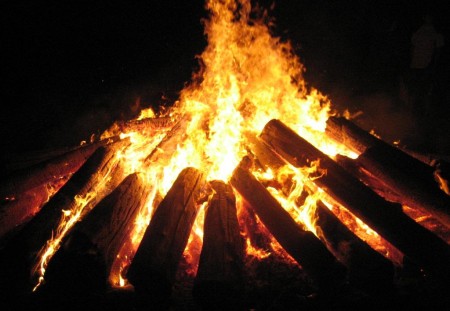My memories of celebrating Lohri in Patiala are a bit hazy. But yes, winter was the season when beeji, my grandmother would painstakingly chop sarson ka saag and then cook it in a haandi on a mud angeethi. The prepared saag always topped with a dollop of homemade butter never ever saw the inside of a blender..it had a textured consistency that comes from hours of slow cooking. Every mouthful had the crunch of onion and ginger. It was slightly bitter but sweetened by a few chunks of seared tomato pieces and then eaten with a makki ki roti or steaming rice. Lohri also meant an abundance of rewri and gajak. My favourite was chikki, the nutty gur delight that basically summed up the season with its sweetness, its crunch and the warmth it left in the wake of every bite. The old women in the mohalla must have coined the quip, “Aayee Lohri..pala hua kohri” (When Lohri arrives, winter departs like an old leper) though I don’t know for sure.
**
Lohri means many things to the locals.It is a celebration of the winter solistice, of the harvest of sugarcane and a regional interpretation of Makar Sankranti.
In our mohalla with its narrow streets, it was tough to find a place where a Lohri bonfire could be lit. But we usually did it in the small square of space outside our house where a Sikh neighbourhood ended and merged into a Hindu mohalla. Before the big bonfire moment, kids got together and went from house to house singing..
Sundar mundariye ho…
Tera kaun bechaara ho…
Dulla bhatti vaala ho..
Dulle thi viyaahi ho..
Ser shakkar paayi ho...
**
As a habitual observer rather than a participant, I don’t remember being a part of this group very often but yes, the few times that I was, I experienced a great thrill in receiving a 25 paisa coin or a handful of sweets from generous neighbours after we were done singing the Lohri ditty.
**
And on Lohri night, we piled up broken chairs, logs of wood, newspapers and more in that neat little square and then lit it all up. As the fire crackled into life, we threw in rewris and gajak pieces, laughed, squealed as gold sparks cut loose and flew everywhere. In retrospect, I do realise the significance of festive celebrations like this. When you honour nature’s abundance, bond over little community rituals, you stay connected to things that make life memorable and meaningful. Isolation can make us lose sight of living fully in the moment. And lighting a bonfire has a liberating and cathartic impact on the human spirit. You just rid yourself of all that is superfluous and make space for the gifts of spring. Living in a big city has made me self-absorbed and inert but just one childhood memory can soften the edges and bring back the taste of the winter warming saag. This following recipe is created by my mother and like all home chefs, she cooks from memory and with instinct rather than measuring spoons. So just go where this recipe takes you and tweak it according to your taste.
**
Ma ka saag
Chop the sarson ka saag and make sure that only the soft, succulent parts go in. Cook in very little water with a tea spoon of washed green moong daal, a pinch of soaked rice, salt, some coarsely chopped ginger, a few garlic cloves and an onion till the leaves are just done.
Puree the mixture.
Then heat some oil and pop in the saag mixture and add a table spoon of makki ka atta in it.
Add just a little water if the mixture is sticky and keep stirring occasionally for about 30 minutes or till it smells perfect and you will know when it does.
In the north, a lot of people add other vegetables to the saag like finely chopped turnip etc.
For the tadka
Take any amount of pure ghee you are comfortable with, heat it, add some methi seeds, two or three red chillies, a little red pepper, garam masala, haldi if you want, sliced onion, five or six cloves of garlic, strands of ginger, two tomatoes chopped in big pieces and cook till it all smells divine and then pour it over the saag..perfect for a winter day and ready to go with buttered makki ki roti.
 with The New Indian Express
with The New Indian Express
Reema Moudgil works for The New Indian Express, Bangalore, is the author of Perfect Eight, the editor of Chicken Soup for the Soul-Indian Women, an artist, a former RJ and a mother. She dreams of a cottage of her own that opens to a garden and where she can write more books, paint, listen to music and just be.







 with
with
Reminds me of my sweet old memories.
And yes the houses which didn’t entertain us by giving sweets or coins, we all used to run away shouting “Huka bhai huka, aee ghar bukha”